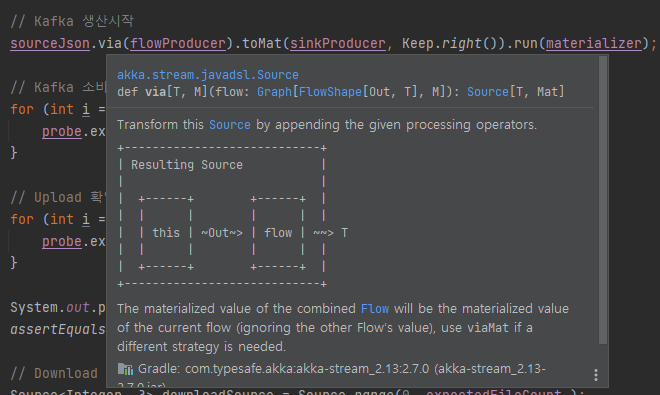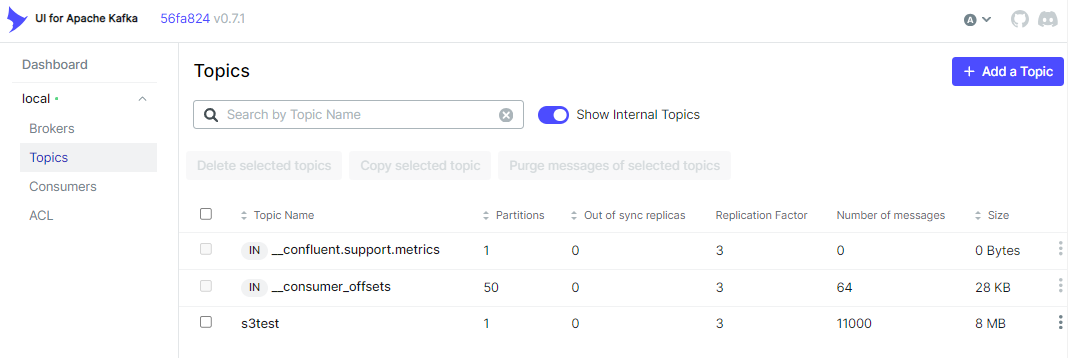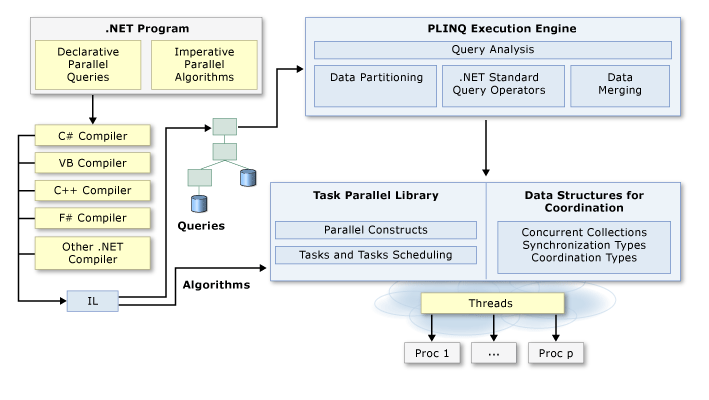DataLake의 데이터 구성요소중 Kafka연동 Parquet 다루는부분을 연구중
Kafka에서 출발한 Json이 최종 S3( Paquet 형식)저장되기 까지 Flow를 단일 로컬지점 유닛테스트화 하여 모두작동하는 변종코드를 작성해보았습니다.
MSA 관점에서 생산과 소비의 책임이 다르기 때문에 어플리케이션이 각각 분리 작동되어야하지만 그것이 잘 작동하는지검증하고 다양한 실험을 해보기까지 너무 오랜시간이 걸릴수 있으며~
유닛테스트를 이용해 우리가 사용해야할 실작동 구성요소를 빠르게 검증하는 활동입니다.
Kafka의 수신검증은 물론 S3저장되기까지 과정에서 작동검사를 위해 , 모두 일시중지해서 블락킹검사를 해야하는 전통적 방식이아닌
모든 모듈이 동시적으로 각각 작동을 하면서 비동기 검사를 수행하며 Flow흐름에 따라 동시성처리를 각각 다른방식을 이용하는것이 아닌 Stream을 활용하는 일괄적 구현방식을 채택하였습니다
/* ProduceAndConsumeToS3AreOK 테스트 시나리오
+--------------+ +--------------+ +--------------+ +--------------+ +--------------+
| | | | | | | | | |
| Kafka | | Kafka | | Flow | | S3 Upload | | S3 DownLoad |
| (Producer) |------->| (Consumer) |------>| Convert |----->| |---->| |
| | | | | Pqrquet | | | | |
| | | | | | | | | |
+--------------+ +--------------+ +--------------+ +--------------+ +--------------+
JSON 이벤트를 N개 발생 -> 수신검증 -> N개씩 파일묶음처리 -> N개파일 업로드검증 -> N개파일 다운로드검증및 데이터 변환검증
*/
AKKA Stream의 Flow요소
AKKA Stream의 코드는 다음과 같은 요소를 이어붙이기 해 복잡한 데이터의 흐름처리를 레고처럼 조립할수 있습니다.
- Source : 처리대상이 되는 원본 데이터입니다.
- Via : 다음으로 흘려보냅니다.
- FlowSome : 사용자의 코드가 실제 구현되는곳으로 데이터를 변환시도할수 있습니다.
- Sink : 스트림의 끝 부분으로, 데이터의 최종 목적지입니다. Sink는 입력 채널만을 가지며, 스트림으로부터 데이터를 받아 그것을 저장하거나, 결과를 반환하거나, 다른 시스템으로 전송하는 등의 작업을 수행합니다. 예를 들어, 데이터베이스에 결과를 저장하거나, 계산 결과를 콘솔에 출력하는 것이 Sink의 역할이 될 수 있습니다.
- run : Sink까지 조립이 완료되면 최종 실행가능한객체로, run이 가능합니다. AkkaSystem이 제공하는 튜닝가능한 Dispacher 실행 영역에서 작동합니다.
Kafka JSON 공통객체 생산하기
Source<String, NotUsed> sourceJson = Source.range(1, testCount)
.map(number -> {
// JSON 형태의 다양한 소스
S3TestJsonModel s3TestJsonModel = new S3TestJsonModel();
s3TestJsonModel.count = number;
String jsonOriginData = mapper.writeValueAsString(s3TestJsonModel);
// 원본 유지를 위한 정의 모델
S3TestModel s3TestModel = new S3TestModel();
s3TestModel.jsonValue = jsonOriginData;
return mapper.writeValueAsString(s3TestModel);
});
Flow<String, ProducerRecord<String, String>, NotUsed> flowProducer = Flow.of(String.class)
.map(value -> new ProducerRecord<>(testTopicName, testKey, value));
Sink<ProducerRecord<String, String>, CompletionStage<Done>> sinkProducer = Producer.plainSink(producerSettings);
sourceJson.via(flowProducer).toMat(sinkProducer, Keep.right()).run(materializer);
이 코드는 카프카가 실제작동하며 JSON으로 토픽 생산을하는 완전한 코드입니다.
이 코드내에서 다음을 고민해볼수 있습니다.
- 모든 JSON객체를 다룰수 있는 공통객체 설계
- 또는 jsonserialize 조차 필요없는 방법 연구 ( 아직 찾지 못했습니다. )
모든 JSON을 담기위한 공통 객체
public class S3TestModel {
public String name = "S3TestModel";
public String version = "0.0.1";
public String jsonValue;
}
public class S3TestJsonChildModel {
public String name = "S3TestJsonChildModel";
public int count = 2;
public String subData = "SomeData";
}
- 모델명과 모델의 버전을 관리하며 , json원본을 최대한 보존하기위해 json객체로 저장을 합니다.
- 모델명과 버전을 생산시점에 표현을 합니다.
- 이것을 소비하는 계층은 N개가 있을수 있습니다. 이것을 생산하는 쪽은 생산의 책임만 집니다.
- 레이크에 저장해야하는 객체는 순수하게 parquet로 저장만 합니다.
- 이 이벤트로인해 서비스의 실시간성이 필요한경우 카프카 토픽을 구독하며, 이미 저장됨으로 원본을 보존하기보다 빠른 서비스처리에 집중합니다.
- 실시간이란 즉각을 표현하는 말로 게임및 동영상 스트리밍등 스트림처리 수준이 높으며, 웹환경에서는 실시간에 가까운 준실시간(NearRealTime) 정도면 충분합니다.
- 이것을 소비하는 계층은 N개가 있을수 있습니다. 이것을 생산하는 쪽은 생산의 책임만 집니다.
Kafka JSON 객체를 소비하여 S3 Parquet로 만들기
Consumer
.plainSource(
consumerSettings,
Subscriptions.topics(testTopicName))
.grouped(maxEntityPerFile)
.to(Sink.foreach(group -> {
S3TestModel model = new S3TestModel();
model.jsonValue = "example data";
Schema schema = new Schema.Parser().parse(schemaString);
// Avro GenericRecord 생성
GenericRecord record = new GenericData.Record(schema);
curFileIdx[0]++;
String dynamicFileKey = fileName + curFileIdx[0];
group.forEach(msg -> {
try {
// AnyJson을 처리할수 있는~ S3TestModel
S3TestModel obj = mapper.readValue(msg.value(), S3TestModel.class);
record.put("name", obj.name);
record.put("jsonValue", obj.jsonValue);
} catch (JsonProcessingException e) {
throw new RuntimeException(e);
}
debugKafkaMsgAndConfirm(msg.key(), msg.value(), confirmActor, testKey, "consumer1");
});
.................
- 발생이벤트에 개수와 상관없이, maxEntityPerFile 규칙에의해 묶음처리를 합니다.
- maxEntityPerFile 규칙에 의해 Entity가 GenericRecord 의 개수만큼 묶음처리되어 파일이 생성됩니다. StreamAPI가 일반적으로 지원하는 기능입니다.
- GenericRecord 객체는 다양한 형태의 json을 Parquet 스키마를 준수하여 변환해줍니다.
S3에 업로드하기
Source.single(byteString)
.runWith(S3.multipartUpload(bucketName, dynamicFileKey)
.withAttributes(S3Attributes.settings(s3Settings)), materializer)
.thenAccept(result -> {
LocalTime now = LocalTime.now();
DateTimeFormatter formatter = DateTimeFormatter.ofPattern("HH:mm:ss");
String formatedNow = now.format(formatter);
System.out.println(formatedNow + " Upload complete: " + result.location());
confirmActor.tell("s3UploadOK", null);
})
.exceptionally(throwable -> {
System.err.println("Upload failed: " + throwable.getMessage());
return null;
});
- parquet 가 만들어지면 이값을 byte화하여 s3에 저장을합니다.
- dynamicFileKey : 팀의 저장단위 규칙이 있다고하면 이것을 준수해 저장할수 있습니다.
S3 다운로드확인
downloadSource
.runForeach(index -> {
String dynamicFileKey = fileName + (index + 1);
// S3에서 파일 다운로드
CompletionStage<Optional<Pair<Source<ByteString, NotUsed>, ObjectMetadata>>> download =
S3.download(bucketName, dynamicFileKey)
.withAttributes(S3Attributes.settings(s3Settings))
.runWith(Sink.head(), materializer);
download.thenAccept(optionalSourcePair -> {
optionalSourcePair.ifPresent(sourcePair -> {
LocalTime now = LocalTime.now();
DateTimeFormatter formatter = DateTimeFormatter.ofPattern("HH:mm:ss");
String formatedNow = now.format(formatter);
Source<ByteString, ?> downloadbyteSource = sourcePair.first();
downloadbyteSource.runWith(Sink.foreach(byteString -> System.out.println(formatedNow + " Downloaded: " + dynamicFileKey)), materializer);
confirmActor.tell("s3DownloadOK", null);
});
})
.exceptionally(throwable -> {
System.err.println("Download failed for " + dynamicFileKey + ": " + throwable.getMessage());
return null;
});
}, materializer);
- 우리가 정한규칙에의해 업로드된 파일을 다시 다운로드 받아서 검증을 할수 있습니다.
- 여기서는 Parquet를 다시 검증하는 부분은 제외되었으며 필요한 검증을 할수 있습니다.
수신검증 유닛테스트
// KAFKA 1개의 메시지 수신받았다는 이벤트를 관찰자에게 비동기적으로 알려줌~
if (testKey.equals(key)) confirmActor.tell("kafkaOK", null);
================= 분리되어 작동가능한 Context =================
// Kafka 소비 메시지 전체 개수가 맞는지 관찰자를 통해 수신검증 확인 , 여기서 지정된 시간안에 검증확인이 안되면 실패로 간주~
// 검증확인이 빠르게 되면 빠른 검증코드 자동종료로 진행
for (int i = 0; i < testCount; i++) {
probe.expectMsg(Duration.ofSeconds(5), "kafkaOK");
}
생산과 소비의 개수를 비동기적으로 할수 있는 간단한 아이디어입니다.
모델검증을 포함할수도 있지만 이것만으로 동시적으로 작동되는 테스트에서 유실없이 모두 처리되었다를 검증할수 있습니다.
- 생산한 메시지가 유실없이 없나 부분은 최조 소비하는쪽의 개수를 통해 검증할수 있으며 기존 시스템을 중단하지않고 메시지큐에 쌓인 검증이벤트를 통해 검사를 할수 있습니다.
추가검증
유닛테스트 통과만으로 복잡한 Flow가 완료되었나를 검증할수 있지만
일반적인 MockServer(페이크) Test가 아닌 실제 장치를 이용한 테스트로
실제 Kafka 장치의 Topic 확인및 개발로그를 확인을 통해 검증및 다양한 추가적인 실험을 한큐에 진행할수 있습니다.
이러한 방법의 도입은 복잡한 Flow처리를 도입해야하기 직전(MSA를 구성하기직전)
복잡한 Flow를 처리할때 연구개발활동을 가속화 할수 있습니다.
코드를 조정하고~ 전체 플로우가 작동되는 반복 테스트는 1분이면 충분합니다.
- 이 테스트는 필요한 메시지큐를 이용해 수신검증 횟수만큼 확인하고 클린 종료되기때문에 작은단위의 로드테스트를 수행하고 성능개선을 할수도 있습니다.
- 무한정으로 작동되는 백그라운드 스레드를 통해 이 기능이 수행되는 경우 일반적으로 , 수신검증후 GraceFulDownn 종료 기능을 유닛테스트내에 탑재하기가 어려울수 있습니다.
인프라 활용계층과 도메인 코드 분리전략
Kafka를 포함 S3 작동 Flow가 짧고 강력한 이유는~ 인프라 활용 계층의 코드와 도메인 로직과 분리가 되었기 때문입니다.
alphaka는 주변 스택을 잘 이해하고 일괄된 방식으로 인프라 계층의 사용전략을 설정화로 다룹니다.
네트워크를 이용하는 스택에서 네트워크 순단은 발생할수 있기때문에 재시도 정책이 설정으로 분리되어 기능을 제공해줍니다.
retry-settings {
max-retries = 3
min-backoff = 200ms
max-backoff = 10s
random-factor = 0.0
}
만약 위와같이 단절상황에 재시도 하는방법을 코드로 정의 한다고하면
특정 예외 상황을 이해하고 재시도하는 로직을 함께 작성할수 있으며 결과적으로 이러한 코드가 늘어나게되면
도메인 로직이 인프라 예외처리코드에 모두 숨겨져 도메인이 작동하는 방식 자체를 이해하기 어렵게 만들수 있습니다.
이 유닛테스트에 사용된 인프라계층의 설정값
# Properties for akka.kafka.ProducerSettings can be
# defined in this section or a configuration section with
# the same layout.
akka.kafka.producer {
# Config path of Akka Discovery method
# "akka.discovery" to use the Akka Discovery method configured for the ActorSystem
discovery-method = akka.discovery
# Set a service name for use with Akka Discovery
# https://doc.akka.io/docs/alpakka-kafka/current/discovery.html
service-name = ""
# Timeout for getting a reply from the discovery-method lookup
resolve-timeout = 3 seconds
# Tuning parameter of how many sends that can run in parallel.
# In 2.0.0: changed the default from 100 to 10000
parallelism = 10000
# Duration to wait for `KafkaProducer.close` to finish.
close-timeout = 60s
# Call `KafkaProducer.close` when the stream is shutdown. This is important to override to false
# when the producer instance is shared across multiple producer stages.
close-on-producer-stop = true
# Fully qualified config path which holds the dispatcher configuration
# to be used by the producer stages. Some blocking may occur.
# When this value is empty, the dispatcher configured for the stream
# will be used.
use-dispatcher = "akka.kafka.default-dispatcher"
# The time interval to commit a transaction when using the `Transactional.sink` or `Transactional.flow`
# for exactly-once-semantics processing.
eos-commit-interval = 100ms
# Properties defined by org.apache.kafka.clients.producer.ProducerConfig
# can be defined in this configuration section.
kafka-clients {
}
}
akka.kafka.consumer {
enable.auto.commit = true
kafka-clients {
bootstrap.servers = "localhost:9092"
}
}
akka.kafka.committer {
# Maximum number of messages in a single commit batch
max-batch = 1000
# Maximum interval between commits
max-interval = 3s
# Parallelsim for async committing
parallelism = 100
# API may change.
# Delivery of commits to the internal actor
# WaitForAck: Expect replies for commits, and backpressure the stream if replies do not arrive.
# SendAndForget: Send off commits to the internal actor without expecting replies (experimental feature since 1.1)
delivery = WaitForAck
# API may change.
# Controls when a `Committable` message is queued to be committed.
# OffsetFirstObserved: When the offset of a message has been successfully produced.
# NextOffsetObserved: When the next offset is observed.
when = OffsetFirstObserved
}
# 이 설정은 유닛테스트를 위한 LocalStack 호환버전이며, AWS-S3이용시 호환은 아래링크 참고 호환을 시킵니다.
# link : https://github.com/akka/alpakka/blob/main/s3/src/main/resources/reference.conf
alpakka.s3 {
buffer = "memory"
disk-buffer-path = ""
# default values for AWS configuration
aws {
credentials {
provider = static
access-key-id = "test"
secret-access-key = "test"
}
region {
provider = static
default-region = "us-east-1"
}
}
path-style-access = true
access-style = virtual
endpoint-url = "http://localhost:4567"
list-bucket-api-version = 2
validate-object-key = true
retry-settings {
max-retries = 3
min-backoff = 200ms
max-backoff = 10s
random-factor = 0.0
}
multipart-upload {
retry-settings = ${alpakka.s3.retry-settings}
}
sign-anonymous-requests = true
}
- 여기서 이용된 kafka / s3 는 인프라 계층으로 설정이 분리되어 있기때문에 도메인(Flow)에만 집중할수 있습니다.
- kafka 작동방식을 config를 통해 설정도 할수 있지만 제공하는 옵션을 통해 kafka 메시지 보장을 위한 전략을 이해하고 채택할수 있습니다.
- 네트워크 단절을 대비한 재시도 정책을 Flow와 분리되어 정의할수 있습니다.
- 예외처리를 포함 재시도 복구 로직이 도메인 로직에 너무 강하게 결합되는경우 도메인 Flow가 재시도 로직에 묻혀 희석될수 있는것에 주의해야합니다.
마무리
AkkaStreamAPI의 함수형접근방식의 개발이 아직은 익숙하지 않은 상태이며 조금더 직관적 방식으로 코드 지속개선중으로
여기서 설명되는 코드는 다음 유닛테스트화되어 전체코드를 살펴볼수 있습니다.
전체코드 :
- https://github.com/psmon/java-labs/blob/master/springweb/src/test/java/com/webnori/springweb/alpakka/reactive/KafkaToAnyTest.java
- https://github.com/psmon/java-labs/blob/master/infra/REAMME.md
추가 도전과제
이 와같은 함수형 Stream방식의 개발방법은 다양한 언어에서도 활용할수 있는 컨셉으로 꼭 AkkaStream이 아니여도 됩니다.
오히려 자신이 가진 기본프레임워크가 강력한 기능을 이미 가지고 있다고 하면 기본 StreamAPI를 이용할것을 권장합니다.
- 자바진영이라고 하면 기본으로 제공 동시성 병렬처리의 개발방법이 만족스럽지 못할수 있으며 이때 Webplux/rx.Java와같이 ReactiveStream을 준수하는것을 채택해서 더 강력해질수 있습니다.
- 닷넷진영의 경우 기본언어 스펙이 오랫동안 제공해온 Linq/TPL/Await 조합이 이미 강력하고 심플하며 대부분 이것만으로 해결되기 때문에 큰 관심사가 아닐수 있습니다.
Erik Meijer의 한마디~ "이보게, 브라이언 괴츠, C#,파이선,자바스크립트는 물론 심지어 PHP도 async, await를 지원하고 있다네. 그런 기능이 없는 언어는 자바일뿐이야. 람다를 이용해서 콜백함수를 사용하면 된다고? 천만에 콜백은 최악이야. 도움이 안된다고. 자바 9 버전에 담으려고 하는 걸 다 내려놓고 지금당장 asymc, await부터 넣으라고. 그래야 모두가 행복해질수 있어"
- 자바진영은 결국 await가 아닌 completedFuture를 기본 채택하였습니다.
다양한 함수형 스트림 처리 개발방식 참고링크
- https://www.baeldung.com/java-9-stream-api
- https://docs.spring.io/spring-framework/reference/overview.html
- https://reactivex.io/
- Java, Scala, C#, C++, Clojure, JavaScript, Python, Groovy, JRuby 등 다양한 언어를 지원합니다.
- https://learn.microsoft.com/ko-kr/dotnet/standard/parallel-programming/
- Future and Promise
기본언어가 채택한 기본기를 먼저 이해한후 우리에게 맞는 방식을 채택하면 되며 AkkaStream일 필요는 없습니다.
요즘 동시성과 병렬성을 함께 다뤄야하는 개발방식이 상호영향을 받아 유사해 보이면서도 차이가 있지만 선택지가 다양해 졌기때문입니다.
우리만의 방법을 채택을 했다면~ 우리가 채택한 개발모델 자체가 유닛테스트 되고 배포없이 로직 개선시도를 해볼수 있는가?는 고민해볼필요가 있습니다.
카프카와 같은 큐시스템을 적극적으로 채택했다고하면 여기서 소개한 이벤트 수신검증 유닛테스트를 각자의 언어에서 동일한 컨셉으로 작동 시도해보는것은 좋은 연습 과제일수 있습니다.
연관 컨텐츠:
- 00.UnitTest - 유닛테스트 기본 컨셉
- https://github.com/psmon/NetCoreLabs - 닷넷에서도 유사 컨셉을 연구하고 있습니다.
상위 페이지 : alpakka






1 Comment
Anonymous
좋은 글 감사합니다
Add Comment